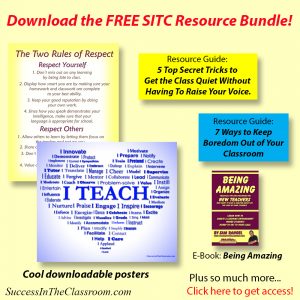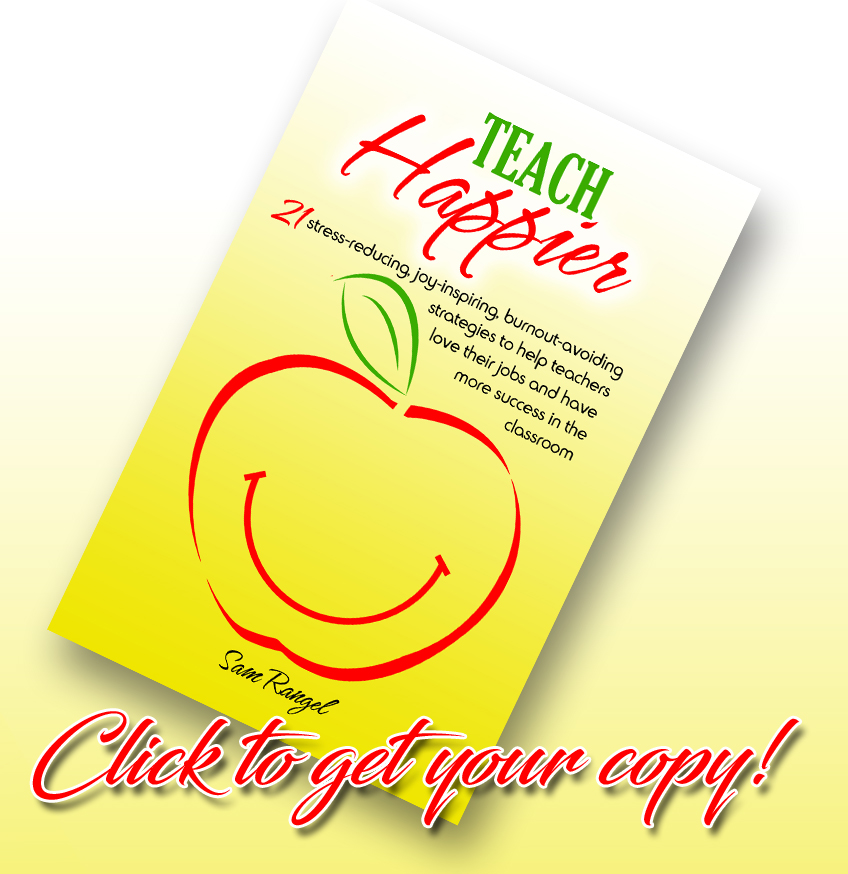
Hello again,
Here’s the next installment in my Less-Stressful Evaluation Series. In this post, I talk about the second state standard for teachers: Creating & Maintaining Effective Environments for Student Learning.
I know these posts are long, and I’m not covering the standards well enough, I know. I just hope that these posts will help new teachers or prospective teachers be more successful when it comes time to get that evaluation.
I wish I had something like this when I started back 23 years ago.
Ready? Here we go….
Standard 2.1 Promoting social development and responsibility within a caring community where each student is treated fairly and respectfully
Standard 2.1 has to do with the safety of the class. You as the teacher are the person responsible for making your classroom a place where students are free to express themselves and to take risks. For example, I like having my students present in front of the class whenever we have a project due. One of the things I make sure to start each presentation session with is a short lecture on respect. I tell my students that there will be no inappropriate laughing, no negative comments, and if I have to interrupt the presenter to tell someone to be quiet, then it’s an automatic detention. Also, even if the presentation is garbage, I always compliment the student when he/she is finished. I never use sarcasm or in any way belittle the student. Neither do I allow other students to disrespect my presenters. Eighth graders are notorious for their cruelty to each other. I do not allow that in my class.
Standard 2.2 Creating physical or virtual learning environments that promote student learning, reflect diversity, and encourage constructive and productive interactions among students
Standard 2.2 is again one of those standards where you consciously evaluate your classroom’s environment. Although you may have students with different ability levels, you can’t make that obvious in your classroom design. For example, you can’t have the Honors students on one side of the room and the students with learning disabilities on the other side. You can’t have your groups arranged by ability levels either. What happens is that the students will identify themselves as either smart or dumb. They won’t see your good intentions. They’ll only see that they are different, and that will inhibit their ability to learn. Mixing the different groups in your class may make it more difficult for you, but the point is to do what is best for the students.
Standard 2.3 Establishing and maintaining learning environments that are physically, intellectually, and emotionally safe
Standard 2.3 is again restating what you’re trying to do with the first two standards. You want to make your classroom a place where the student is not going to be treated poorly or without care and concern. We have to remember, some of our students come from home lives where mom and dad are not caring. We need to make sure that our classroom is a place where that child will feel safe and cared for. It may his/her only true escape.
Standard 2.4 Creating a rigorous learning environment with high expectations and appropriate support for all students
Standard 2.4 just reminds us to make sure that our work is not just busy work. We have to make sure that our students are going to be stretched to higher levels. Having said that, it would be easy just to give really hard work, but that second part tells me that I need to make sure that the student will have the support to successfully complete that work. I can’t rely on the parents to help the student at home. Many parents don’t have the education required to help the student or they don’t speak the language or they just aren’t there. I have to make sure that the work is challenging, yet complete-able. (I think I just made up that word.)
Standard 2.5 Developing, communicating, and maintaining high standards for individual and group behavior
Behavior is a big issue in 8th grade. Basically, this standard is telling the teacher to make sure that poor behavior is addressed and not encouraged. It would be nice to be able to eliminate poor behavior, but that’s not going to happen. You can, however, make each event a learning experience, by handing out appropriate consequences. You can’t let poor behavior continue. Many of my student teachers will just ignore it, and then what happens? Yup, it gets worse. How do you deal with poor behavior? Well, that’s for another post. That’s for like a hundred other posts.
Standard 2.6 Employing classroom routines, procedures, norms, and supports for positive behavior to ensure a climate in which all students can learn
Standard 2.6 asks the teacher to have structure to the class. Students need to know what to expect when they come into your room. I put an agenda on the board, an objective for the day’s lesson, and I always start the class the same way: Today in American History. This is like a sponge activity where I go over historic events that happened on that particular day. It’s also a place where I celebrate students’ birthdays. Your opening routine sets the mood for the rest of the period. I suggest to my student teachers to come up with a 10 minute class starter that stays the same throughout the year. Students need structure, especially in 8th grade. The other part is having some way to reward students when they do something good. It can be an early to lunch pass, class money, pieces of candy, etc. Let the kids know that there are rewards for good behavior in your class.
Standard 2.7 Using instructional time to optimize learning
Standard 2.7 is basically telling the teachers to not waste minutes in the period. Sometimes, a teacher will finish the lesson before the period ends, and will tell the class, “Do something quietly for the next 10 minutes.” Don’t do this. Always plan extra. I have to admit, I sometimes have extra minutes left, but I always have a mini lesson in my back pocket, just in case. This comes with experience. Eventually, you’ll be able to gauge your lessons to the minutes in the period.
Again, I didn’t cover everything. There is so much more I could have added, but that would make for a really long post.
I would love to hear your comments, questions, even complaints.
Next time I’ll talk about the third standard: Understanding and Organizing Subject Matter for Student Learning.
Until then,
Thanks,
Sam



